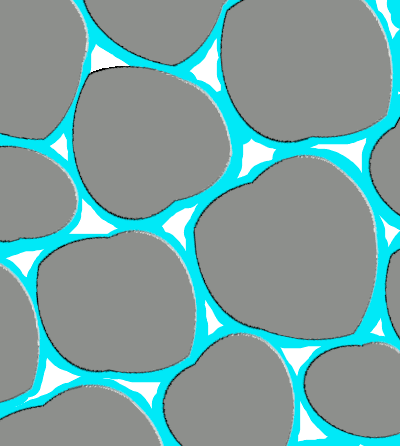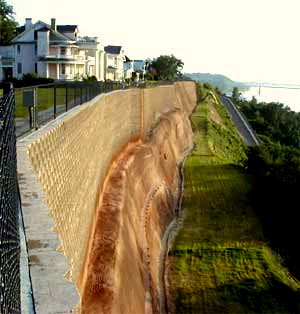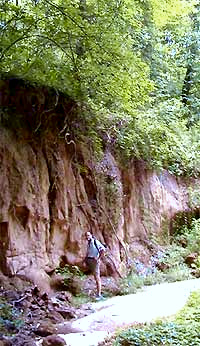 Scrapped-off powder from a clump of German loess; Image courtesy of 'Sciencia58' and Wikimedia Commons
Scrapped-off powder from a clump of German loess; Image courtesy of 'Sciencia58' and Wikimedia CommonsLoess is, basically, compacted dust. However, it's dust of a certain kind.
During the 1960s, a team from Millsaps College in Jackson, Mississippi conducted a battery of tests on Mississippi loess. Their findings were published in 1968 as Mississippi Geological, Economic & Topographical Survey Bulletin 111, Loess Investigations in Mississippi.
Consequently, today we have a good picture of exactly what our loess is. Among many features, maybe the most distinctive are the following:
Loess particles have a particular range of sizes. Average "dirt" is composed of particles of many sizes, ranging from relatively large grains of sand (0.05-2.0 mm diameter) to particles of silt (0.002- 0.05mm), down to particles of clay (smaller than 0.002 mm). Diameters of most Mississippi loess particles are amazingly uniform, centering in the "medium silt" range. This is caused by wind sorting. Larger particles were too large for the wind to carry, smaller ones were carried beyond the loess-bluff zone.

Loess particles tend to be more or less spherical and of approximately similar size. This causes the soil to drain better than might be expected of a soil composed of such small-grained particles. When subspherical loess particles of similar size pack together, air spaces form between them, as shown at the right. In that diagram the blue represents a thin film of water adsorbed to the dark mineral particles, and white is open space. If smaller particles were present, they'd clog the spaces, blocking the flow of water and air.

Loess becomes gravy-like when saturated with water. When the air spaces mentioned above become filled with water, the roundish loess particles stop adhering to one another. If you place your wet hand in the sand, sand grains adhere to your hand. If you then stick your sand-coated wet hand into water, the sand grains fall off. In the same way, once loess soil is saturated with water, the mineral particles no longer attract one another. When there's little holding the waterlogged soil together, the soil becomes slush. At the left, the U.S. Army Corps of Engineers has done some fancy and expensive work to keep the loess bluff from collapsing when it became saturated with water.
Loess particles are composed of certain minerals. Like sand at the beach, loess is mostly (about three-quarters) quartz, SiO2. The Millsaps College team found that of the remaining one-quarter non-quartz minerals, loess was about 20% carbonate, mainly in the dolomite form, CaMg(CO3)2. The next largest component, at about 6.5% of content, was potash feldspar, KAlSi3O8. By the way, the 20% carbonate has meant a lot to farmers in the loess zone. In the same way modern farmers add lime to their soil that has become too acidic, early farmers in the Natchez area used unleached loess to neutralize the soil in their fields.
About 2% of loess content is composed of a hodgepodge of minerals which look very interesting through a microscope. There are green and brown varieties of biotite, clear muscovite, pale-green to brownish green epidote, red and yellow rutile, pale yellow staurolite, brown and green forms of tourmaline, almost spherical, colorless grains of zircon, green hornblende, black ilmenite, magnetized grains of magnetite, reddish hematite, and even pale pink and colorless varieties of garnet, and more.

In the bottom of our Loess Hills ravines or bayous you're bound to find with the stream-bottom gravel and sand something looking like the picture above. That's about a foot long and probably formed around a tree root growing through the loess. Geologically, it's a kind of concretion, which is a hard, compact mass of matter cemented together by mineral "cement" between the particles' open spaces. In our loess, the cement is calcium-rich "marl" and other minerals, which also form hard-to-remove white rings in pots of boiling, evaporating water.

Loess particles erode steep faces, as shown at the left. Different theories seek to explain why this happens, but here we'll stick to the simple observation offered by Earl Manning in Tulane's Geology Department. Loess produces steep walls "just because the very homogeneous silt particles pack together so well (with or without any added clay). Most sediment is reduced by slumping to the standard angle-of-repose because there are planes of weakness where different sized particles are adjacent. Loess defeats the normal angle-of-repose."
Loess comes in two different colors: Earl Manning also points this out to us: "Fresh, unweathered loess, which has not yet oxidized the iron from ferrous to ferric, is bluegray in color, and often contains carbonized plant remains. As it's exposed, it turns to the yellowish tan most people think of. Often, in a fresh-cut exposure, there's a sharp line dividing the gray part below and the tan part above. This is an important point to a geologist, as people confuse the two types as two different beds."